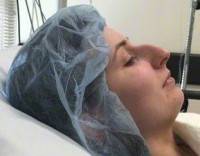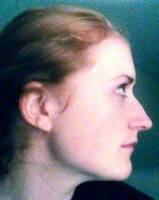Nose Bone Osteotomy
Filing down a small nasal hump
Small residual nasal humps can gently be filed down especially if they are the result of trauma with a rasp.
This can often be done without doing osteotomies to narrow and infracture or break the nose.
However, if the hump is very large and you file it down to provide a smooth profile, then you will need to do osteotomies to narrow the nose and close the flat spot called an “open roof”.
This is analogous to building a house. If you take down the roof it is open unless you push the walls closer together. A small hump can be simply filed away.
The other part of your question keeping the tip the same is possible with or without osteotomies.
In fact, even if osteotomies are needed you can leave your tip position and shape alone. (Scott Trimas, MD, Jacksonville Facial Plastic Surgeon)
Correction of the nasal hump without breaking the nasal bones.
This can be done by filing it down only when the hump is small. Otherwise the nasal bones will be apart and flat.
This is why we have to do osteotomies when we remove the average sized hump. (Toby Mayer, MD, Beverly Hills Facial Plastic Surgeon)
Sometimes you don’t need osteotomy in rhinoplasty.
Of course, the surgical plan is made only after detailed examination. So I don’t know exactly what you need. But we do see patients in whom the bump can be lowered with a rhinoplasty without osteotomies. (George J. Beraka, MD (retired), Manhattan Plastic Surgeon)
Dorsal nasal rasping without the need for osteotomies
You can perform a slight bridge correction with rasping alone, but it is for very select patients. One, is that patient that has a very subtle dorsal hump, and I would agree that 1 mm is about all that can be safely removed. Any more than this, and the rasp will uncover the intranasal cavity, which shows up externally as a slight single or double depression on each side of the septum that runs vertically in the upper third of the nose.
As mentioned, the second part of an open roof deformity means the remaining nasal bones are wider than the original dorsal line, so paradoxically the bridge actually appears fatter. For this reason, most patients undergoing bridge reduction rhinoplasty require additional steps called osteotomies to infracture the bony pyramid and correct this deformity.
The second patient that is a candidate for dorsal rasping without osteotomies would be those with small focal irregularities. Whether from a fracture, prior rhinoplasty, or post surgical graft irregularities, small bumps can often be addressed this way as well.
Very safe and predictable and variable based on need. I have even narrowed a few dorsal lines this way by conservatively shaping only the side of the bony pyramid peak that creates the line that defines the top of the nose. One last idea.
In select patients, meaning those that are tough, or not troubled by surgical procedures, I have done these also under local anesthesia only (or you could add a mild oral sedation pill).
Wierd for patients, still it still requires local anesthesia too, but tolerable, and saves recovery time and money. (Kevin Robertson, MD, Madison Facial Plastic Surgeon)
Dorsal hump removal without osteotomy depends
This all depends on the extent of the dorsal hump. I have taken some down that do not need an osteotomy and others that did. If its a small dorsal hump then its possible, if its on the larger side, you may need an osteotomy in order to prevent an “open roof deformity”.
An open roof deformity is, if you can imagine what would happen to the roof of a house if you shaved the top off, you’d have an open roof. (Oleh Slupchynskyj, MD, FACS, New York Facial Plastic Surgeon)
Breaking Bones in Rhinoplasty osteotomy
Based on proper and extensive pre-operative analysis of your nose, your surgeon will determine whether an osteotomy (nose break) is needed or not. This depends on how wide the shadows and lines that cme from your eyebrows down to your tip are. Measurments and close evaluation of your photos will dictate the need for bone manipulation. Trust your surgeon and make sure you go to a surgeon who really “knows noses.” (Ashkan Ghavami, MD, Beverly Hills Plastic Surgeon)
Rhinoplasty osteotomy may require cutting the bones
Depending on your anatomy and your goals, osteotomies (or controlled cutting of the bones) may be required to achieve the desired results during a rhinoplasty osteotomy.
Often, if a hump is taken down, an open roof deformity results (“gap on top of your nose”) which must be narrowed.
This will also require osteotomies. Breaking the bones is a crude term and does not accurately describe what we do. (Corey S. Maas, MD, San Francisco Facial Plastic Surgeon)
Breaking nasal bones during rhinoplasty osteotomy sounds much worse than it actually is
Breaking the patient’s nasal bones during rhinoplasty osteotomy is often a necessary component of the operation. However, in those patients who need only a tip refinement this can be accomplished without any bony work. Incidentally, in theses cases there is no post-op bruising.
There are generally two circumstances that lead to the need for the surgeon to fracture your nasal bones. The first occurs when the nasal profile is being straightened by reducing a hump.
After the hump is essentially shaved down the bridge would look too flat and wide if left this way. At this point the surgeon will break the nose to narrow the nasal bones thereby once again establishing a normal width to the bridge.
The second occurs when the patients nose is too wide from the beginning and then the bridge is narrowed, once again by fracturing the bones, as part of the overall nasal narrowing. Whenever the nasal bones are worked upon this inevitably leads to the classic bruised and swollen post rhinoplasty look. Surprisingly, as bad as this may look the patients are actually quite comfortable.
The majority of my Rhinoplasty patients, even if their bones have been fractured, require little if any pain medication. In otherwords, they look much worse then they feel. Therefore, don’t be turned off to Rhinoplasty should your surgeon express the need to break your bones as part ot the procedure. (David A. Ross, MD, Chicago Plastic Surgeon)
Refining the nasal bone contour is important in most cosmetic rhinoplasties
Alteration of the nasal bone contour is frequently a necessary step in cosmetic rhinoplasty osteotomy in order to refine the appearance of the nose. Don’t think of it as “breaking” the nose because it’s really an osteotomy. We take a special instrument that cuts the bone with surgical and artistic precsion and modify the bone contour in a very controlled fashion.
“Breaking the bones” sounds too brutish, and in fact is inacurate. As an aside, there are also rhinoplasty operations that improve breathing and are not cosmetic in nature. Providing the nose is reasonably straight, alteration of the nasal bone contour with osteotomies is typically not necessary in these cases. (Randolph Capone, MD, Baltimore Facial Plastic Surgeon)
Infracturing the nose is done to narrow the base (the bottom of the pyramid that is attached to the facial bones. This is usually an operative decision although pre-op evaluation can generally make a good prediction as to whether that maneuver will be performed. I find computer imaging very useful for the patient. (Vincent N. Zubowicz, MD, Atlanta Plastic Surgeon)
Breaking the nose is a common part of rhinoplasty
Breaking the nose is such a harsh term! How about narrowing the nose? This sounds better, doesn’t it? Most patients seeking rhinoplasty have a large hump on their nose and have large tips. The hump of the nose is similar to a pyramid.
What happens when one shaves the hump (the top of the pyramid) down? The rest of the nose (pyramid) will appear wider. Therefore, it is necessary to narrow the nasal bones to make the nose balanced. Yes, this is done by making small breaks in the base of your nasal bones and then pressing them in.
The good news is, you will either be under general anesthesia (which is the method preferred by most rhinoplasty surgeons) or IV sedation. You should not feel or remember any part of your surgery. And “breaking the bone” really is not as bad as it sounds. (Michael A. Jazayeri, MD, Santa Ana Plastic Surgeon)
Breaking the nasal bones (osteotomies) during rhinoplasty allows narrowing of the bridge of the nose. It is routinely performed when a large hump is removed from the dorsum.
If you have a large hump, you are likely to need osteotomies. You are not unique in fearing this part of the procedure.
During the actual procedure, you will not feel this maneuver, and you will not remember it after the operation. So don’t allow this fear to consume you. (Maurice M. Khosh, MD, New York Facial Plastic Surgeon)
Breaking the Nose During Rhinoplasty
Rest assured, any reputable rhinoplasty surgeon would have a lengthy discussion with you preoperatively if they were going to break your nose.
What many people refer to as ‘breaking the nose’ actually refers to a maneuver called an ‘osteotomy’ that involves very precise cutting used during surgery.
Most osteotomies are done to narrow the nose to create a more defined frontal shadow. They are also used commonly to straighten a crooked nose deformity.
Most experienced rhinoplasty surgeons perform osteotomies with great precision. This also means that swelling and bruising from the osteotomy should be minimal following surgery. Breaking the nose has been mistakenly viewed by many patients as a very traumatic experience when, in fact, it really isn’t. It is typically no more uncomfortable than any other maneuver performed in rhinoplasty. One difference between having an osteotomy and not having one performed is the nasal cast.
If your is ‘broken’ during surgery, an external cast is placed to keep the bones in position. If not, then you will likely only have soft bandages and tape on the nose. Don’t be intimidated or turned off to the idea of rhinoplasty just because you have to have the nose broken. (John M. Hilinski, MD, San Diego Facial Plastic Surgeon)
Osteotomies (surgically breaking the nasal bones) is not done in all rhinoplasties. It depends on what is necessary to improve your appearance.
You will know before surgery if this will be necessary. Don’t fear this maneuver; with good anesthesia you will be unaware. (Richard W. Fleming, MD, Beverly Hills Facial Plastic Surgeon)
Nose Breaking (Osteotomy) during a Nose Job (Rhinoplasty)
A Nose Job (Osteotomy rhinoplasty) is a sculpting procedure. In order to shape the height and width of the nose, the nose may have to be broken in very precise directional fractures (called OSTEOTOMIES) along the side (LATERAL) or the top (DORSAL) of the nose.
These controlled fractures fractures are usually done from inside the nose or through a small opening along the side skin. In the vast majority of cases these heal beautifully and are not anything you should worry about. (Peter A. Aldea, MD, Memphis Plastic Surgeon)
Do you have to break my nose?
Breaking the nose or performing an osteotomy is almost a routine part of nose surgery. It is rare that I do not have to perform osteotomies during the procedure. The reason that nose surgery requires osteotomies is to narrow and shape the nose.
After the hump is removed or the tip is narrowed the bones need to be narrowed as well. Every part of the nose is interrelated and must be treated accordingly. (Carlos Wolf, MD, Miami Facial Plastic Surgeon)
Rhinoplasty doesn’t necessarily require your nose to be snapped
In general, every technique in rhinoplasty is only done if you want your nose to be narrower on the upper third, or if it is shaven down on the dorsum so much that it needs to bring together the sides. Not every rhinoplasty needs it, but when it is needed you definitely don’t want to find out when it’s too late. If your plastic surgeon recommends it, I wouldn’t skimp on something like that. (Ricardo A. Meade, MD, Dallas Plastic Surgeon)
Breaking the nose during a rhinoplasty (Osteotomy rhinoplasty)
I hate the term breaking, because the bones are actually cut and moved. This can actually be done rather gently. Because patients are most often under conscious sedation (or rarely completely asleep), they do not remember the experience. And it does not contribute to additonal pain postoperatively. If your plastic surgeon deems the procedure necessary, you should take his or her advice; even though it can sometimes be avoided completely. (Howard T. Bellin, MD (retired), Manhattan Plastic Surgeon)


